Make timely and appropriate decisions in achieving zero infection
Sewage surveillance helps detect COVID-19 cases
31 January 2021
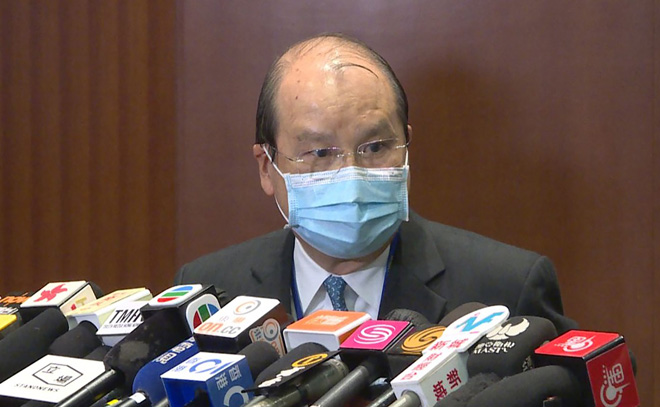
|
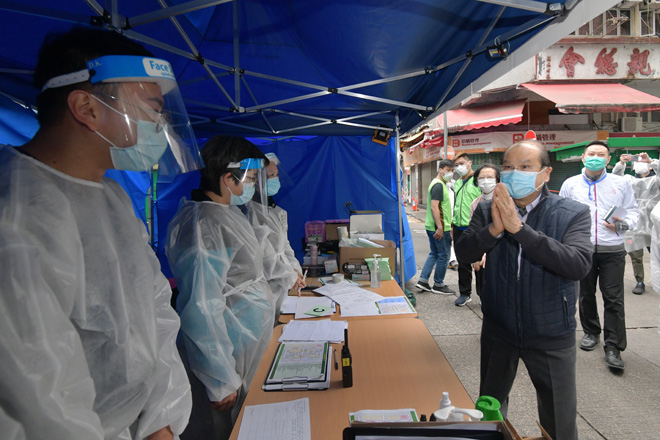
|
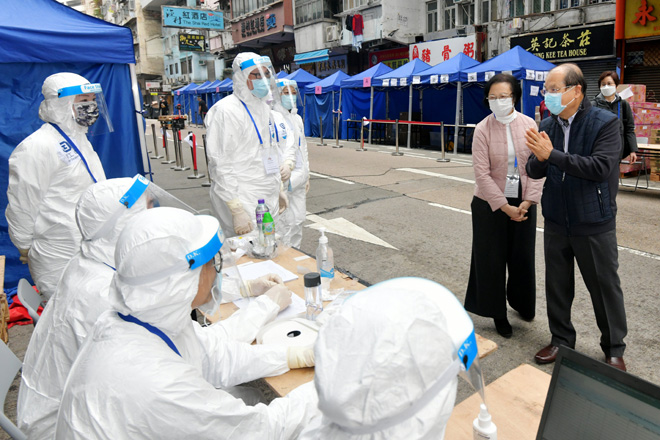
|
Last Wednesday (January 27), the Chief Executive (CE) conducted her annual reporting of work to President Xi Jinping and Premier Li Keqiang separately, during which she reported the latest economic, social and political situation in Hong Kong. The CE expressed gratitude to the state leaders for fully acknowledging the work of the Hong Kong Special Administrative Region (HKSAR) Government in the past year, and for the care and support from the Central Government to Hong Kong on the prevention and control of the COVID-19 epidemic, economic development and improvement of people’s livelihood.
President Xi extended his warmest regards to the people of Hong Kong and, expressing grave concern and care about the fourth-wave epidemic here, pledged unswerving support for our combat against the virus. Such deep solicitude from the country is indeed reassuring and heartening.
The country’s support is the strongest backing and greatest advantage for Hong Kong in winning through the epidemic battle. We are profoundly grateful to the Central Government for offering assistance in various aspects, including sending support teams to help us through the Universal Community Testing Programme which was successfully implemented in September last year; and assisting in the enhancement of community treatment facilities as well as the construction of a temporary hospital to boost Hong Kong’s anti-epidemic capabilities. All these have given Hong Kong a much-needed shot in the arm.
Implementing prevention and control measures based on actual scenarios
Achieving “zero infection” tops the agenda of the HKSAR Government’s anti-epidemic work. We will take timely and appropriate action by employing precise, decisive, stringent and effective anti-epidemic measures based on actual local scenarios. It is our goal to curb the spread of the virus in the community with the use of “fast, accurate and resolute” tactics, and effectively safeguard public health and safety as a whole.
The Government’s steely determination to combat the epidemic has manifested itself in our continued efforts to ramp up “compulsory testing on a mandatory basis”. In just one week’s time, we have carried out three compulsory testing operations at “restricted areas”. The one taken in Jordan on January 23 and 24 was the first-ever operation with a restriction-testing declaration made to cordon off an area as the specified “restricted area”. After taking stock of the experience gained, we had three targets set for future operations, with the aim to keep them confidential, be more focused in delineating restricted areas and compress the time frame. We then adapted the strategy for the restriction-testing declarations made in respect of the specified “restricted area” in Yau Ma Tei last Tuesday (January 26) and of Blocks A to D of Tung Fat Building in North Point last Thursday (January 28).
These precise and risk-based operations were proven effective in identifying asymptomatic patients in the community. Adopting a people-oriented approach, the operations were completed swiftly in a specified time frame to minimise the impact on the public. The Government will continue to step up, speed up and scale up operations of this kind having regard to development of the epidemic and actual needs.
The operation at the “restricted area” in Jordan identified 13 confirmed cases out of over 7 000 virus tests among residents from over 150 buildings (a positive rate of 0.17%); while the one at the “restricted area” in Yau Ma Tei identified one confirmed case out of over 300 samples tested (a positive rate of approximately 0.3%). These operations not only identified infected patients for early treatment, but also located their close contacts, thus achieving early identification, early isolation and early treatment. Even though no confirmed cases were identified in the operation at Blocks A to D of Tung Fat Building in North Point, the operation was indeed warranted to achieve “zero infection” in the area and allay residents’ worries.
I wish to emphasise that asymptomatic patients may spread the virus without even knowing it. The Government will take each and every infection source seriously because a single confirmed case can trigger off transmission and spreading of the virus, and may even result in large cluster outbreaks. Therefore, we must never let down our guard and should make every endeavour to achieve “zero infection”.
I also wish to point out that enforcement actions will still continue even though the restriction-testing declarations for the “restricted areas” will be revoked after the test results have been ascertained. The Government will track down undetected cases, seriously follow up on the compliance of compulsory testing notices and restriction-testing declarations by persons subject to compulsory testing, and take enforcement actions where necessary. Any person who fails to comply with the compulsory testing notice commits an offence and may be liable to a fixed penalty of $5,000. The person will also be issued with a compulsory testing order, requiring him/her to undergo testing within a specified time frame. Failure to comply with the order or the restriction-testing declaration is an offence and the offender may be liable to a fine of level 4 ($25,000) and imprisonment for six months. Last week, the Government issued fixed penalty notices to some 30 citizens in the “restricted areas” for non-compliance of the compulsory testing notices.
Standing shoulder-to-shoulder in the epidemic battle
Colleagues of the Home Affairs Department and the Department of Health played a crucial role in the compulsory testing operations. More than 3 000 civil servants including some staff of disciplined services and civilian grades from various departments also zealously contributed to the operations. Faced with unprecedented challenges in Hong Kong, civil servants from different departments are all pitching in with devotion and dedication. The Government fully recognises and immensely appreciates their commitment and perseverance in serving the community.
The fight against the epidemic is a prolonged one. It is incumbent upon civil servants at all levels to participate in the anti-epidemic work. We will not rule out the need to conduct compulsory testing in different areas in various scales or forms at short notice. Therefore, the Government has already requested all departments to make adequate preparations in terms of manpower and resources allocation such that they can mobilise their staff within a short time frame to take part in front-line anti-epidemic operations. Departments will deploy their manpower flexibly and put in strenuous efforts with a view to containing the epidemic as soon as possible.
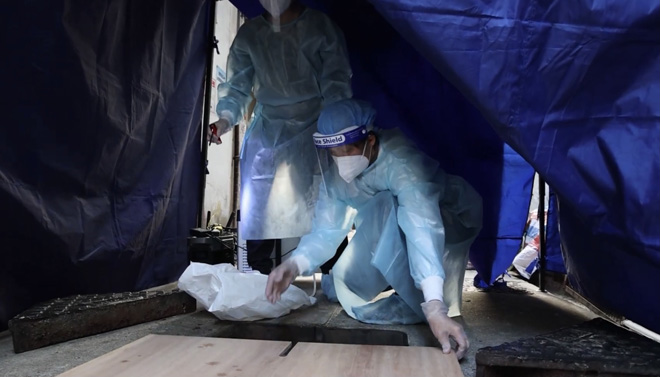
|
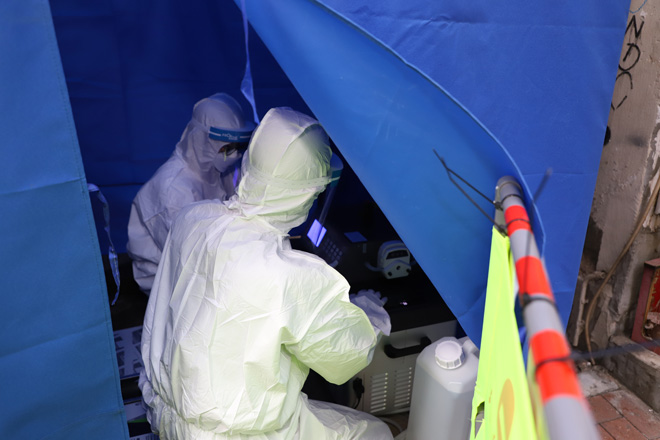
|
Identifying infection sources by means of sewage surveillance
Since the outbreak of the fourth-wave epidemic, the Environmental Protection Department (EPD) and the Drainage Services Department (DSD) have collaborated with an expert team at the University of Hong Kong (HKU) to employ a methodology at its development stage in support of the anti-epidemic work. Their expertise in sewerage network analysis and strategic sampling planning was drawn on to track down potential COVID-19 patients at residential buildings with infected clusters. Thanks to this methodology, the health authorities could then follow up with compulsory testing orders issued, and subsequently located a total of 10 infected cases in Choi Wan (II) Estate. This case is the first of its kind where COVID-19 patients were successfully identified in the community through integrating sewage-related virus surveillance with compulsory testing.
This breakthrough heralds Hong Kong’s achievements in technological innovation. Since the first half of last year, the cross-disciplinary expert team led by Professor ZHANG Tong of HKU’s Department of Civil Engineering has been optimising and validating the key experimental steps in the pre-treatment of sewage samples, as well as the detection and quantification processes in the context of Hong Kong. The team has developed systematic methods for analysing COVID-19 virus in sewage by using the technologies of two-stage ultra-fast centrifugal filter for pre-concentration and double gene fragments for detection.
With the epidemic emerging in some old districts, the team further adjusted the strategy and focused sewage testing on the city blocks in these districts to identify areas with viral presence to facilitate health protection teams in issuing compulsory testing orders and taking other follow-up actions. In Jordan, for example, where a number of sewage samples taken from different city blocks within the “specified area” were tested positive from January 16 to 21, reference was made to the distribution of these positive sewage test results when delineating the “restricted area” for actions on January 23 and 24. As a result, 13 more confirmed cases were identified, attesting once again the effectiveness of sewage-related virus surveillance in identifying infection sources.
Sewage surveillance is a race against the clock. To facilitate comprehensive real-time situational analysis, the EPD has applied smart technology of the Geographical Information System to consolidate and display on a map visualised information such as daily test results, sampling locations, associated sewerage catchment areas, buildings subject to compulsory testing and sewerage network. Meanwhile, the DSD is also conducting site visits and sampling planning at manholes, enabling swift adjustments in light of the development of the epidemic and making sampling work at targeted areas possible with just one to two days’ preparation. With such measures in place, it is hoped that asymptomatic patients and their close contacts can be identified and isolated, and the transmission chain can be cut as soon as possible.
While both the Government and HKU strive to boost their sampling and testing capacities, sewage surveillance has recently been extended to various districts across the territory. Since the beginning of this month, the Government has not only initiated the procurement of advanced testing equipment, but also actively liaised with HKU, private laboratories and contractors to transfer the surveillance technology to enterprises, thereby further expanding Hong Kong’s surveillance capacity. It is hoped that the surveillance service would be made available not only to the Government, but also to other organisations and the wider community to scale up the territory’s anti-epidemic efforts. It is also our hope that the successful development and application of advanced technologies in Hong Kong could be shared with the rest of the world.
Conclusion
Curbing the epidemic is the top priority of the HKSAR Government. We will sustain our best efforts towards this goal with a clear head and a steady hand. As long as we stay united, I believe Hong Kong will soon overcome and win through.
In addition to the epidemic, the HKSAR Government was faced with the onslaught arising from the opposition to the proposed amendments to the Fugitive Offenders Ordinance and the adverse changes in the external environment over the past year. With the support and assistance of the Central Government, the implementation of the Hong Kong National Security Law (HKNSL) has reversed the chaotic situation in the past, returning peace to society and bringing Hong Kong back on track gradually.
The HKSAR Government will fully enforce the HKNSL to prevent and suppress acts endangering national security while ensuring the continued success of “One Country, Two Systems”. The stability and security that we have right now are hard-earned and hence all the more valuable. Once the epidemic is brought under control, and our daily lives and the cross-boundary activities between Hong Kong and the Mainland resume normal, our economy will steadily pick up. We will then be back the right track towards prosperity and stability.

